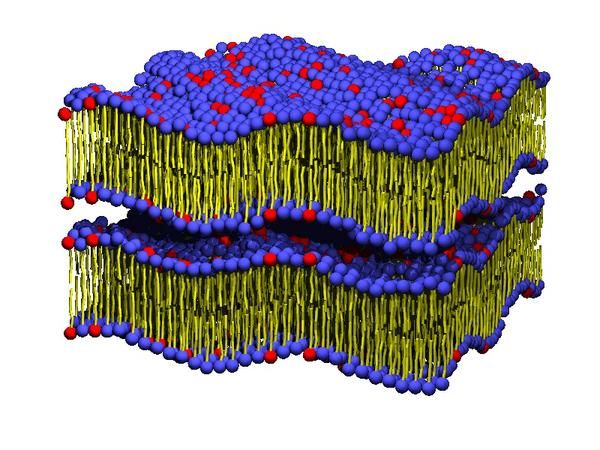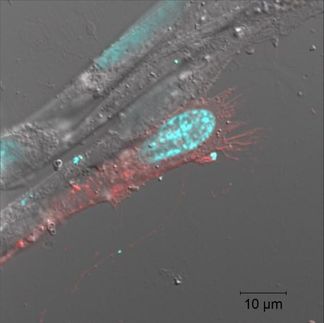Researchers watch lipid molecules in motion
X-ray stroboscope offers new insights into biomolecular dynamics
Researchers from Göttingen in collaboration with colleagues from Augsburg have 'filmed' the movement of lipid molecules using an X-ray stroboscope at DESY. In the scientific journal Physical Review Letters, researchers lead by Professor Tim Salditt of the University of Göttingen report that their study offers new insights into the dynamics of biomolecules, which compose materials such as cell membranes. The cell membranes consist of a double layer of lipid molecules; the properties of the membranes are of great interest because they control which substances enter and exit a biological cell and also determine which materials are exchanged between different cell regions.

Excitation of a stack of lipid membranes by ultra sound leads to collective oscillations which have been probed by time-resolved diffraction.
Tobias Reusch/Tim Salditt, University of Göttingen
Biomolecules are by nature very mobile. When influenced by heat, they vibrate, turn and stretch. Because these movements constantly overlap, the membrane structure can in most cases be experimentally determined only as an average. “In order to directly track the changes in molecular structure, the spatial resolution must be higher than a millionth of a millimetre and the temporal resolution must be faster than billionth of a second so that the extremely fast movement isn't blurred," explains Salditt.
Both of these conditions are fulfilled by DESY’s research light source PETRA III, which provides very bright and short X-ray pulses. Using those pulses, the researchers ‘filmed’ the motion of a stack of lipid membranes which were externally excited by controlled vibrations using ultrasound. “For the experiment, the membrane vibrations haven been precisely synchronized with the X-ray pulse frequency so that the X-ray flashes captured the movement of the membranes like a stroboscope during different phases,” explains DESY scientist Dr. Oliver Seeck, head of the X-ray diffraction experiment P08, where the studies took place. In order to do so, the scientists observed how the X-ray light was scattered on the membranes at different times, thus determining the time-dependent structure.
The researchers observed that the ultrasonic waves not only cause the membranes to vibrate similar to a drumhead, but the microscopic structure is also affected. “Those membranes consisting of molecular lipid bilayers changed both their thickness and their density periodically under the influence of the externally forced motion,” said University of Göttingen’s Dr. Tobias Reusch, first author of the study. “In order to do so, the molecular lipid chains must collectively stretch and compress, as shown by the density profiles, which we have recorded for each point of oscillation.”
“Similar structural changes could also result in membranes of biological cells from temporal fluctuation of forces,” explains Salditt. “The visualization of the changes in molecular structure using our stroboscope method makes possible new insights regarding the properties of this ‘soft’ material.”
Original publication
Most read news
Original publication
"Collective lipid bilayer dynamics excited by surface acoustic waves"; T. Reusch, F. J. R. Schülein, J. D. Nicolas, M. Osterhoff, A. Beerlink, H. J. Krenner, M. Müller, A. Wixforth, and T. Salditt; "Physical Review Letters", 2014.
Organizations
Other news from the department science

Get the analytics and lab tech industry in your inbox
By submitting this form you agree that LUMITOS AG will send you the newsletter(s) selected above by email. Your data will not be passed on to third parties. Your data will be stored and processed in accordance with our data protection regulations. LUMITOS may contact you by email for the purpose of advertising or market and opinion surveys. You can revoke your consent at any time without giving reasons to LUMITOS AG, Ernst-Augustin-Str. 2, 12489 Berlin, Germany or by e-mail at revoke@lumitos.com with effect for the future. In addition, each email contains a link to unsubscribe from the corresponding newsletter.



























































